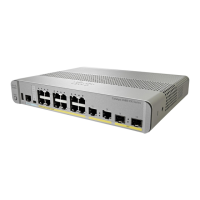39-6
Catalyst 3750-X and 3560-X Switch Software Configuration Guide
OL-21521-01
Chapter 39 Configuring QoS
Understanding QoS
For IP traffic, you have these classification options as shown in Figure 39-3:
• Trust the DSCP value in the incoming packet (configure the port to trust DSCP), and assign the same
DSCP value to the packet. The IETF defines the 6 most-significant bits of the 1-byte ToS field as
the DSCP. The priority represented by a particular DSCP value is configurable. DSCP values range
from 0 to 63.
You can also classify IP traffic based on IPv6 DSCP.
For ports that are on the boundary between two Q
oS administrative domains, you can modify the
DSCP to another value by using the configurable DSCP-to-DSCP-mutation map.
• Trust the IP precedence value in the incoming packet (configure the port to trust IP precedence), and
generate a DSCP value for the packet by using the configurable IP-precedence-to-DSCP map. The
IP Version 4 specification defines the 3 most-significant bits of the 1-byte ToS field as the IP
precedence. IP precedence values range from 0 for low priority to 7 for high priority.
You can also classify IP traffic based on IPv6 precedence.
• Trust the CoS value (if present) in the incoming packet, and generate a DSCP value for the packet by
using the CoS-to-DSCP map. If the CoS value is not present, use the default port CoS value.
• Override the configured CoS of incoming packets, and apply the default port CoS value to them. For
IPv6 packets, the DSCP value is rewritten by using the CoS-to-DSCP map and by using the default
CoS of the port. Yyou can do this for both IPv4 and IPv6 traffic.
Note IPv6 QoS is not supported on switches running the LAN base feature set.
After classification, the packet is sent to the policin
g, marking, and the ingress queueing and scheduling
stages.

